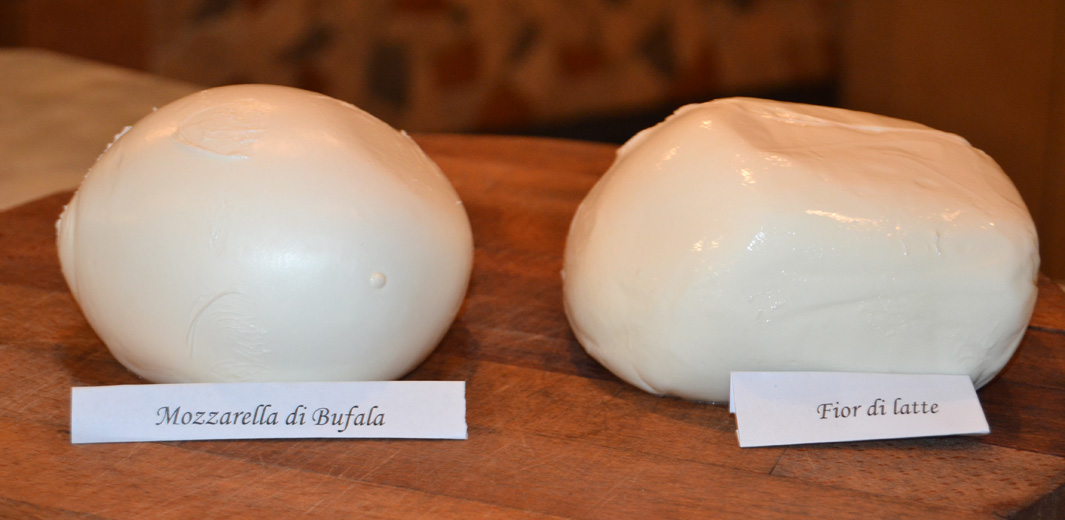by Enzo Coccia
I’d like to shed some light on this dilemma: has the authentic Neapolitan Pizza Margherita to be garnished with the buffalo mozzarella or with the fior di latte? I have already dealt with this topic from a scientific and technical point of view, talking about temperature and pH during the baking and remembering, for example, that the buffalo mozzarella has to be cut in slices while the fior di latte in strips, as the decalogue of the true Neapolitan pizza imposes (for further information you just have to read what I wrote on January 9, 2015).
However, today I’d like to do an historic reflection on this matter, remembering, as an attentive pizzaiolo, that the mozzarella melts and the fior di latte forms a string, but both are well linked to lycopene in tomatoes! Follow my reasoning and you will understand that the choice between one or the other is not a matter of “trend”, but it depends on the ability of the pizzaiolo to meet the customers’ different budgets.
The buffalo mozzarella, as we all know, is a fresh cheese with spun dough made with buffalo’s milk, produced and known already in ancient times. Indeed, around 1200 the monks of Monastery of Capua offered this cheese to the devotees on pilgrimage. At that time, since the present refrigeration systems didn’t exist, so as not to lose the cow’s milk and to store it for a couple of days, they learned to process it, producing, thus, the mozzarella. The Sele plain was the ideal habitat for the buffalo breeding with its wetlands and swamps that let the buffalos, animals with many sebaceous glands and a limited number of sweat ones, live in the wild and defend themselves from high heat by splashing around in the water and covering their bodies in mud.
The historical book in which we read that the “mozzarella” was used on the pizza dates back to 1866 (Usi e Costumi di Napoli – Customs and Traditions of Naples by Francesco de Bourcard), while a few years before him, Gaetano Valeriani, in his books Napoli in miniatura (Naples in miniature), written in 1847, described how Porta Capuana’s pizzas were prepared and he wrote something about the “dairy products”: “A questa pasta distesa in forma circolare, viene rialzato l’orlo e, ricoperta di olio o di lardo (‘nzogna), vi si aggiunge un po’ di sale, sempre s’intende sulla superficie. Talora vi pongon sopra pomidori crudi, tal’altra pesci, altra ancora latticini…” (To this rounded shaped dough, the edge is risen and, garnished with some oil and lard, a little of salt is added on its surface. Sometimes, some raw tomatoes are put on top, sometimes fishes, sometimes dairy products).
Now everyone may say that the word “mozzarella” refers to both the fresh cheese made with cow’s milk and the one which is made with buffalo’s milk as the words dairy products and mozzarella do not specify which of the two is and both follow the method known as mozzatura (which means to cut).
So, I quote the Act I of the comedy Don Liberato si spassa conceived in 1941 and written by the great Neapolitan comedy writer and author Libero Bovio, which, speaking to a boy, says: “Porta sta pizza con pomodoro e mozzarella al tavolo 3” (Bring this pizza with tomato and mozzarella to table 3). Bovio referred to the buffalo mozzarella; if he wanted to refer to the cow’s milk mozzarella he would have said: “Bring the pizza with tomato and fior di latte to table 3”.
In conclusion, the term “fior di latte” has been part of Neapolitans’ everyday language for centuries to indicate a fresh cheese made with cow’s milk, which was produced in Agerola area already in the mid-nineteenth century. I am sure that the pizza was garnished depending on the customers’ different budgets, so some pizzas had the buffalo mozzarella while some others the fior di latte on top. In fact the poor ate the “pizza alla Cosacca”, garnished with oil, tomato, pecorino cheese and basil only. To conclude I mention the famous Eduardo de Filippo: spaghetti with clams or spaghetti alle vongole fujute (with “escaped clams”)?




















